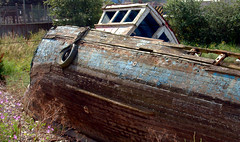Nearly 5,000 recreational boats are retired and disposed of every year in Norway- either sunk to the bottom of the sea or burned in a bonfire. Now, researchers have developed a new method for recycling these vessels.
There are one million recreational boats in Norway, and another 35,000 new boats are purchased and added to the fleet every year. Cabin cruisers, yachts and small boats — big or small, they all rely on composite materials for the hull and the superstructure. The reason for this is that composites are made of cross-linked polyester and fibreglass, which makes them lightweight yet strong.
The only problem is that when a recreational boat gets old and the owner is ready to discard it, there is no way to dispose of it properly — there is no place to take it, and no way to recycle the materials it contains.
“Plastic shopping bags can be melted down and processed, but composite materials have molecular bonds that are not easily broken down,” says SINTEF research director Fabrice Lapique.
In response to this problem, Veolia, a recycling company, started a project three years ago in collaboration with SINTEF Materials and Chemistry, the Norwegian Composite Association, Reichhold and Nordboat. The effort is being supported by the Research Council of Norway. The project called for industry partners to evaluate possibilities for the collection, dismantling and transport of the different fractions of cast-off boats, while the scientists examined whether it is possible to recover the composites from the vessels, and figure out what they can potentially be used for.
Chemical recycling
The results are now available, and are very good. During the course of the project, SINTEF has developed different methods and found a chemical process that makes it possible to separate the polyester and fibreglass so that both products can be reused.
“The process is very effective,” says Lapique. “The level of usability varies from property to property, but is around 80 per cent. And best of all is that the process is easy to implement in an industrial context. Within two hours, more than 80 per cent of the material has been dissolved and the temperature during the process does not exceed 220 degrees.”










